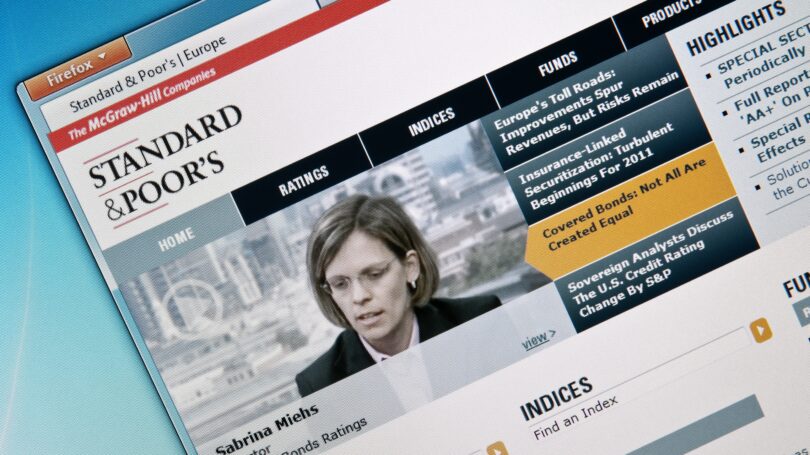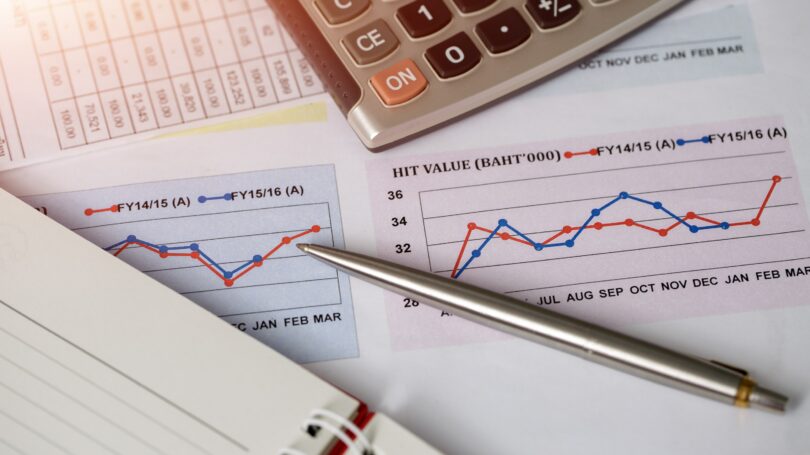Standard and Poor’s (commonly known as S&P) is one of the most prominent financial intelligence companies in the world. S&P is a division of the McGraw-Hill Companies and has more than 150 years of experience providing financial services to investors worldwide.
Though the firm provides a number of financial research services, they are most widely known for their credit ratings.
History of S&P
S&P’s history can be traced back to 1860, when Henry Varnum Poor published “The History of Railroads and Canals in the United States.” Eight years later, Poor and his son founded H.V. and H.W. Poor Co, a firm dedicated to providing financial statistics on railroad companies. Within the next five years, Poor’s company became one of the leading firms on Wall Street. Later, in 1919, the firm was renamed Poor’s Publishing.
A few decades later, another financial visionary came forward with ambitions similar to Poor’s. Luther Lee Blake wanted to provide financial information to all companies, and in order to bring this dream to life, Blake created the Standard Statistics Bureau in 1906. While Poor created manuals of financial data on the railroad companies, Blake created 5×7-inch cards with financial news items. In 1913, Blake also started producing full reports on stocks and bonds after purchasing the Babson Stock and Bond Card System.
The Standard Statistics and Poor’s Publishing Merger
By the 1920s, both Poor’s Publishing and Standard Statistics started providing ratings on companies that reflected their ability to satisfy debts. While Poor’s Publishing handled corporate bonds, Standard Statistics rated municipal securities. It was only natural that these two parallel entities would eventually collaborate, and in 1941, Standard Statistics and Poor’s Publishing merged to become Standard and Poor’s Corporation.
Over the next decade, Standard and Poor’s Corporation became a successful financial services company in spite of the economic challenges brought on by World War II only one year after their merger.
Post-War Advances Capitalize on Computer Industry
Following WWII, S&P recognized the opportunity to capitalize on recent advances in computer automation in order to expand their services and influence. They had been tracking an index of 90 stocks, but were interested in providing more comprehensive, real-time coverage.
In 1957, thanks to new technology, they were able to introduce the S&P 500, which tracked 500 publicly held companies on a weighted basis according to their market capitalization. Without major advances in the computer industry, tracking such a large index would not have been possible.
Expanding Services and Product Offerings
In 1966, Standard and Poor’s was purchased by the McGraw-Hill Companies. McGraw-Hill Companies decided to expand Standard and Poor’s rating services, and in 1974 they started charging issuers for the ratings they provided. By 1976 the Securities and Exchange Commission recognized Standard and Poor’s as a Nationally Recognized Statistical Rating Organization (NRSRO).
In the 1980s, Standard and Poor’s developed offices in London and Tokyo and became a global company. Today, S&P is one of the Big Three credit rating agencies. Presently, all three firms use slightly different rating scales that are based off of Fitch’s model.
 Details of the S&P Rating Scale
Details of the S&P Rating Scale
S&P developed the standard rating scale used by the other big credit rating agencies to rate both short- and long-term debt. Ratings can be particularly useful to understand the creditworthiness of bonds and bond issuers. However, they can also be used to gauge the overall financial health of a company, even if an investor is not interested in purchasing a bond. For example, someone who needs insurance could look to an insurance company’s S&P rating to understand how likely they are to be able to pay out a claim.
S&P classifies all debt as either “investment grade” or “non-investment grade,” which quickly reflects how “risky” that debt is. A debt instrument, such as a bond, is classified as investment grade if S&P feels there is a strong likelihood that the debtor will be able to repay that debt. On the other hand, a non-investment grade debt instrument is one that S&P deems the issuer may have a difficult time repaying.
S&P classifies all debt-issuing entities they review according to the following scale:
- AAA, AA+, AA, and AA- (Very High Capacity to Repay Loans). S&P provides an AAA rating to any borrower that has an extremely high capacity to repay its debt. Although debt instruments with AA+, AA, and AA- ratings do not meet the stringent criteria to earn an AAA rating, they still have a very high capacity to repay their loans due to their financial position and attitude towards repaying debt. In other words, they are considered to have a very low chance of defaulting.
- A+, A, and A- (Strong Capacity to Repay Loans). Some borrowers are financially stable under current economic conditions. However, S&P acknowledges that certain companies, though stable now, will have more difficulty repaying their loans if economic conditions change. Therefore, S&P rates these debt instruments as A+, A, or A-.
- BBB+, BBB, and BBB- (Adequate Capacity to Repay Loans). Some borrowers have a more modest ability to repay their loans than others. These borrowers have demonstrated they are committed to repaying their loans and have the capacity to do so. However, their ability to repay is less assured and more vulnerable to changing economic conditions than the previous ratings. The ability to repay is less assured and more vulnerable to changing economic conditions than the previous ratings. These are the lowest investment grade bond ratings S&P assigns.
Investment grade bonds issuers have a high capacity to repay their debt. However, borrowers will be rated as non-investment grade if S&P is more uncertain about their ability.
The rating scale for speculative grade bonds (which are generally higher yielding bonds due to the risk premium) is outlined below:
- BB+, BB, and BB- (Less Vulnerable Speculative Grade Bonds). S&P assigns these ratings to borrowers who face a number of ongoing problems that raise concerns over their ability to repay debt. However, some debt instruments are less vulnerable than others to short-term economic conditions, such as temporary changes in interest rates. Should a company fall into this category, S&P will assign it a rating of BB+, BB, or BB-.
- B+, B, and B- (More Vulnerable Speculative Grade Bonds). S&P will assign a “more vulnerable” rating to a debt instrument that currently has the ability to repay its debt, but is very likely to face challenges if economic or financial conditions change. Although these firms do not raise any major concerns under present conditions, they are dependent on highly favorable conditions to continue repaying their debt in the future.
- CCC, CC, and C (Currently Vulnerable Speculative Grade Bonds). S&P will rate a firm as “currently vulnerable” if it is facing problems that limit its ability to meet its debt obligations. Unlike the speculative grade bonds above, the borrower is already facing significant challenges and is at higher risk of default if financial conditions change. A borrower will be assigned a CCC rating if it is currently vulnerable. However, a borrower may also receive a rating of CC if S&P is concerned that the firm is on the verge of bankruptcy. Even worse, a C rating may be assigned to a borrower that has filed a bankruptcy petition.
- D (Default). S&P will assign a D rating to any company that has already defaulted on its obligations. Obviously, this is the worst rating any borrower can receive.
 How S&P Differs From Other Rating Agencies
How S&P Differs From Other Rating Agencies
Although there are many similarities between the ratings scales used by S&P and the other credit rating agencies, S&P has a different philosophy and methodology. Namely, S&P is only focused on the likelihood that a borrower will default.
Measuring Probability of Default vs. Potential Losses
Other rating agencies, such as Moody’s, are interested in the potential losses an investor will face. When these agencies conduct ratings, they evaluate how long it may take for a borrower to default. Also, they consider the loss investors will face if a default occurs.
For example, Moody’s will give borrowers a higher rating if a default will not be very costly to investors. However, S&P is only focused on the probability of whether a default will occur.
Differing Sovereign Debt Ratings
The difference between the models explains why ratings for the company can vary significantly between rating agencies. This difference can be obvious in sovereign debt ratings, which partially explains why S&P downgraded the United States after the debacle on raising the national debt ceiling, while Moody’s and Fitch did not.
The other rating agencies believed that if the United States defaulted on its debt, the default would only last for a few weeks at most. Also, they believed that the default would not cost investors a substantial amount of money. Therefore, they felt that the United States was still a fairly safe investment. S&P, however, felt the United States no longer demonstrated an extremely high ability to repay its debt obligations and stripped it of its AAA rating.
Providing Investors With Debt Obligation Snapshots
According to Reuter’s columnist Felix Salmon, S&P does not position itself as an investment adviser. Unlike Moody’s and Fitch, it does not give investors an overall view of the risk attached to a debt instrument. Instead, it merely provides investors a snapshot of a borrower’s likelihood to meet its debt obligations.
Final Word
Rating agencies specialize in assessing the creditworthiness of businesses, so investors place high emphasis on their opinion as they attempt to establish the level of risk associated with a debt instrument. These investors place particularly high regard on the opinion of the most revered rating agency in the world: S&P.
Not surprisingly, investors may pay closer attention to debts that have been upgraded by S&P and may dump bonds that have been downgraded. Moreover, S&P’s opinion can substantially influence the morale of investors all over the world, as evidenced by the market performance after S&P downgraded the United States sovereign debt.